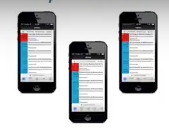Background:
Effective patient handoffs during care transitions are crucial in the skilled nursing home setting where physician providers may not round on a daily basis, and the healthcare facility staff has shift changes on a daily basis. Currently, many critical communications regarding patients are shared via private phone calls, text messages, emails and log books. Often, these communications are not documented relative to the patient, nor are they shared in real time with the entire care team.
Purpose:
The goal of this project was to implement eHealthPartner’s (www.ehealthpartner.com) communication, scheduling and care transition software in a 300 bed skilled nursing and long-term healthcare facility. Patient handoffs between the physician provider team and the healthcare facility interdisciplinary team were enabled by using eHealthPartner’s website and integrated smartphone app.
Description:
In a collaborative effort, more that 70 clinical users including the nursing team, therapy team, and social services team agreed to document patient concerns on the healthcare facility website. Every communication was documented relative to a patient’s name and shared with the appropriate physician provider team on the smartphone app. The physician provider teams, including Attending Physicians, Nurse Practitioners, and Physician Assistants agreed to receive and document responses on the smart phone app. In addition, all users were able to schedule patient evaluations and communicate care transitions. By creating a common interface all members of the care team were able to efficiently share and communicate concerns, schedule evaluations and care transition patients in real time. Communications were color coded by type, for example urgent communications requiring a response were coded red with alert escalation so that critical information was acknowledged. In a 3-month period, over 3000 clinical communications were shared between the healthcare facility team and the physician provider team. A monthly average of 600 patient evaluations were scheduled for urgent clinical concerns. An improvement in 30-day hospital readmission rates was observed during this period, although the implementation of the software may not be the only explanation for this.
Conclusions:
By documenting all clinical concerns, the care teams enabled communication with each other during and after nursing and physician provider shift change. Both the physician provider teams and facility care teams cited that a significant amount of time was saved and that communication was clearer with documented communications as compared to verbal communications. In addition, the physician provider team was able to share communications, scheduling of patient evaluations and care transitions with each other, during rounding and call rotations. Documentation and sharing of patient concerns involves a significant collaborative effort between the healthcare facility team and the physician provider team and may enable effective patient handoffs.
